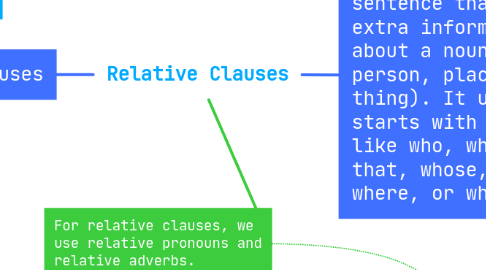Relative Clauses
作者:SERGIO HENRIQUE SOARES DE SOUZA

1. Relative Clause is a part of a sentence that gives extra information about a noun (a person, place, or thing). It usually starts with words like who, which, that, whose, whom, where, or when.
2. The girl who sits next to me is my best friend. "who sits next to me" is the relative clause. It tells us more about "the girl."
3. This is the book that I borrowed from the library. "that I borrowed from the library" gives extra details about "the book."
4. Examples
5. Types of Relative Clauses
6. Defining Relative Clauses – These give essential information. Without them, the sentence wouldn’t make sense. Example: The dog that lives next door is very friendly.
7. Non-defining Relative Clauses – These just add extra details. You can remove them, and the sentence will still be complete. They are separated by commas. Example: My brother, who loves football, plays for the school team.
8. I have a friend whose brother is a famous singer. "whose brother is a famous singer" tells us about "a friend."
9. For relative clauses, we use relative pronouns and relative adverbs.
10. Relative Adverbs (Used for time, place, and reason): where → for places (This is the school where I study.) when → for times (I remember the day when we first met.) why → for reasons (The reason why I’m late is traffic.)
11. Relative Pronouns (Used for people, things, and possession): who → for people (The boy who won the race is my friend.) whom → for people (more formal, often in written English) (The person whom I met was very kind.) which → for things (The book which I read was amazing.) that → for people or things (The dog that lives next door is very cute.) whose → to show possession (The girl whose phone is lost is looking for it.)


